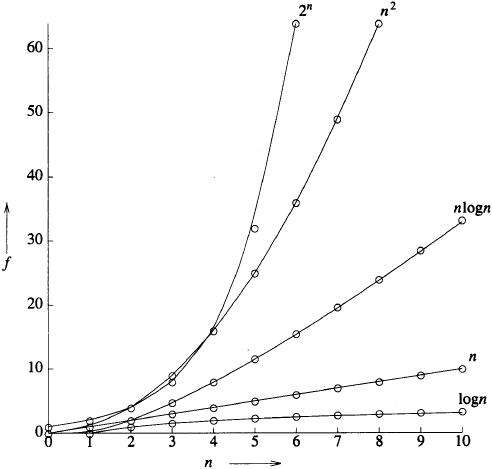算法的时间复杂度
算法时间复杂度用来度量算法执行时间的多少,用T(n)=O(f(n)),其中n为问题规模,也就是问题的大小。
# 时间复杂度,用来估算算法运行效率的
print("hello world") # T(n) = O(1)
for i in range(n):
print("hello world") # T(n) = O(n)
for i in range(n):
for j in range(n):
print("hello world") # T(n) = O(n**2)
for i in range(n):
for j in range(n):
for k in range(n):
print("hello world") # T(n) = O(n**3)
# T(n) = O(log n)
def foo(n):
while n >1:
print(n)
n = n //2
foo(64)
常见的时间复杂度
O(1) < O(logn) < O(n) < O(nlogn) < O(n2) < O(n2logn) < O(n3)

简单判断时间复杂度的方法
1.有循环减半的过程 O(log n)
2.几次循环就是n的几次方 O(n**n)
空间复杂度
空间复杂度:用来评估算法内存占用大小的一个式子
1.程序只有变量
S(n) = O(1)
2.程序需要一个一维数组
S(n) = O(n)
3.程序有一个二维数组
S(n) = O(n2)
一般情况下,会用空间复杂度,换取时间复杂度
二分法查找
li = list(range(100000))
# 二分法查找
def bin_search(li, num):
high = len(li)-1
low = 0
while high >= low:
mid = (high + low) // 2
if li[mid] == num:
return mid
elif li[mid] > num:
high = mid -1
else:
low = mid + 1
return None
# 尾递归二分法查找
def bin_search2(li, num, low, high):
if low <= high:
mid = (low + high) // 2
if li[mid] == num:
return mid
elif li[mid] >= num:
bin_search2(li, num, low, mid-1)
else:
bin_search2(li, num, low+1, high)
else:
return
二分法示例
# 1.二分法查找相同数
# Given an array of integers sorted in ascending order, find the starting and ending position of a given target value.
# Your algorithm's runtime complexity must be in the order of O(log n).
# If the target is not found in the array, return [-1, -1].
# For example,
# Given [5, 7, 7, 8, 8, 10] and target value 8,
# return [3, 4].
def bin_search(li, target):
# 先利用二分法,匹配到mid。
# 开两个for循环,依次从mid往左和往右查找,直到第一个不等于TARGET的时候返回
low = 0
high = len(li) - 1
while low <= high:
mid = (low + high) // 2
if li[mid] == target:
a = mid
b = mid
while li[a] == target and a >= 0: # and 条件在最开始
a -= 1
while li[b] == target and b < len(li) - 1:
b += 1
return (a + 1, b)
elif li[mid] > target:
high = mid - 1
else:
low = mid + 1
return None
print(bin_search([1, 1, 3, 5, 6, 7, 8, 9, 10, 10], 10))
# 2.
# Given an array of integers,
# return indices of the two numbers such that they add up to a specific target.
# You may assume that each input would have exactly one solution,
# and you may not use the same element twice.
# Example
# Given nums = [2, 7, 11, 15], target = 9,
# Because nums[0] + nums[1] = 2 + 7 = 9,
# return [0, 1].
nums = [2, 7, 11, 15]
def twoSum(nums, target):
'''
时间复杂度O(N**2), 两层循环,依次匹配
:param nums:
:param target:
:return:
'''
for i in range(len(nums)):
for j in range(i + 1, len(nums)):
if nums[i] + nums[j] == target:
return i, j
return None
# print(twoSum(nums, 18))
def tow_sum_2(nums, target):
# TODO:fOr 循环固定单个值, 用target - 固定值, 用二分法查待匹配的值。
def two_sum_3(nums, target):
# 列表有序,初始值 Sum = Num[low]+Num[high]
# 从最左和最右移动索
low = 0
high = len(nums) - 1
while low < high:
sum = nums[low] + nums[high] # 列表有序,初始 sum = 列表最小值+最大值
if sum > target:
high -= 1
elif sum < target:
low += 1
else:
return low, high
return -1, -1
print(two_sum_3(nums, 22))
# TODO:尝试目标值由三个数相加得来,返回三个下标。